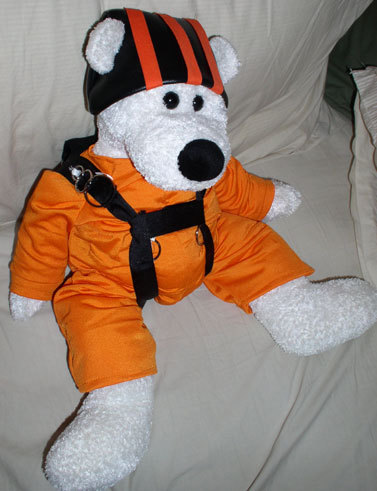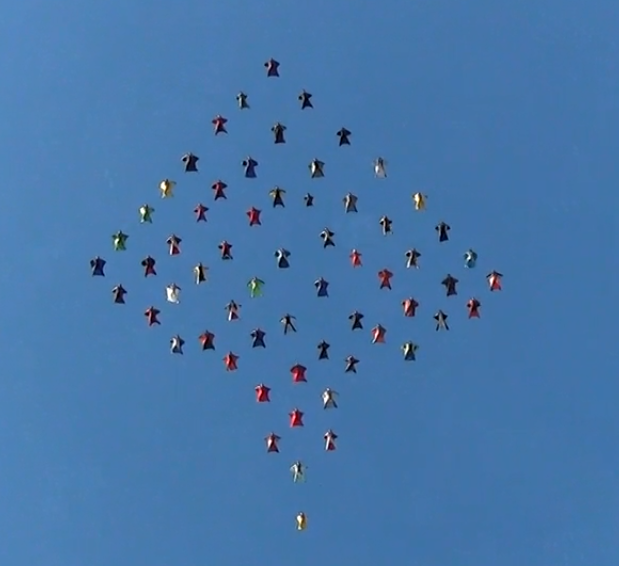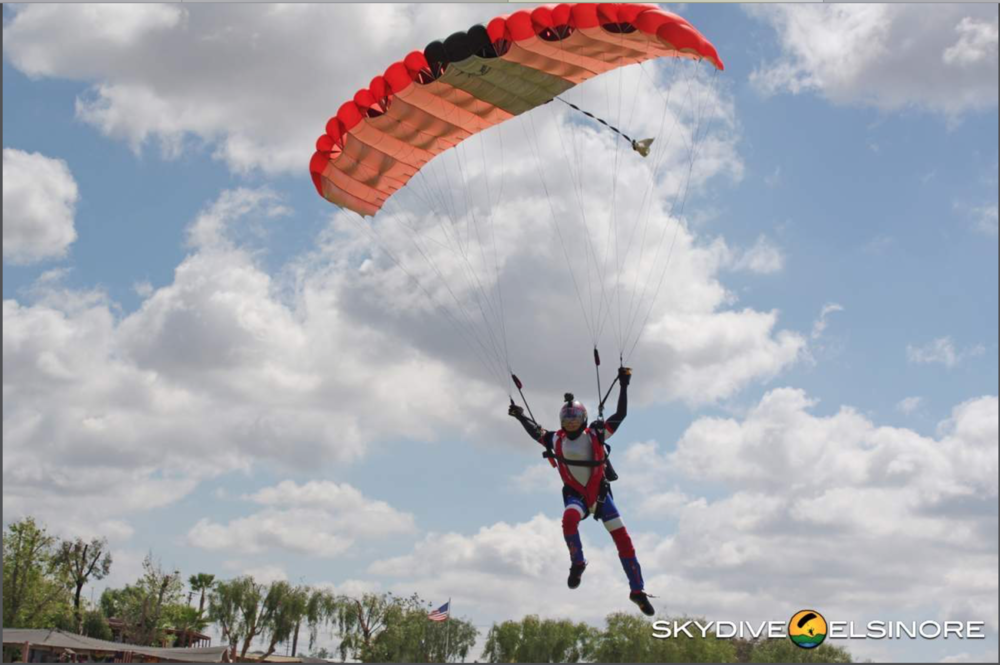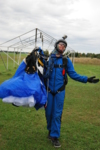Recommended Posts
billvon 3,100
Because while hypersonic it has an L/D of about 1; that's about the same as a really good tracker. Subsonic it rises to about 4, so you _might_ be able to get enough speed to climb for a bit, but it would be a very transient (and somewhat dangerous) event.
(As a good illustration of what a bad glider the Shuttle was, pilots noted they were glad they were wearing harnesses as they were on final approach; it kept them from falling down onto the instrument panel.)
dthames 0
QuoteDan, learn to flat track well. That is the best thing to do.
Many try to re-invent the wheel. Many don't realize that their "new" ideas have already been thought of and tested and determined short on being "best practices".
I asked the question because my second jump with any tracking, I tracked right past my coach and on the video you can see I was moving pretty slowly. I know I don't know what I am doing and it will get better. A couple jumps later I tracked for about 10-12 seconds and I was loving it. I was told I was a bit steep and needed to track "flatter".
On a jump yesterday I moved my shoulder shape a bit and also the curve of my spine. In the track already I did something to make it a lot steeper and then tried to flatten it out again....then it was time to pull. Lots to learn there.
I like science. That don't mean the math but the process. The Flysight audible GPS has both a horizontal and a vertical mode, where the tone changes based on the vertical speed or the horizontal speed, depending on the mode it is in. A person should be able to tune their tracking shape to give the slowest vertical speed, in vertical mode. The same thing could be done to learn how to adjust your horizontal speed in the track. I would guess that somewhere there is a crossing of the curves to give a good forward speed while giving up the least altitude. That would be the sweet spot and the proper angle of 13 degrees.
rehmwa 2
weird stuff in this thread: The max track has nothing to do with the angle of dive to the earth, nor the angle of drive from the base. That's silly, it's just the body, and the airflow to define it.
if you assume the body is just a flat surface (yes, please crap all over this assumption for simplification purposes ![]() ) - then the most horizontal (outward - tracking) force that you can apply to that body is if the body is angled at 45 degrees to the relative wind (max sideways force). With MOST surface area you have available contacting the airflow.
) - then the most horizontal (outward - tracking) force that you can apply to that body is if the body is angled at 45 degrees to the relative wind (max sideways force). With MOST surface area you have available contacting the airflow.
HOWEVER, that doesn't mean the body is flying at a 45 degree angle to the earth - like a knife cutting through. It just means the wind is hitting it at a 45.
anyone TRYING to purposely drive at a 45 (relative to the ground) to achieve maximum horizontal aerodynamic force is using his physics wrong. The goal is max force by orienting relative to the airflow, not the planet.
I can get the 45 pitch by just diving down my head (removing surface area up top) - I'll descend REALLY fast though.... OR
I can that same great body pitch angle by adding more drag to my booties (which would also be more NET "lift" ![]() to the whole body) - I'll actually descend slower, then, vs when I was flat.
to the whole body) - I'll actually descend slower, then, vs when I was flat.
I'd rather use the second technique - I get going just as fast (goosing it at first doesn't HAVE to use a downward burst, it can goose what addition of more bootie surface) the second way - the visuals are better, and I can track just as fast and for more seconds since I descend slower. (here, the MOST potential will be the flat flyer that's really arching his ass off during the dive - when HE turns to track, he'll have ALL that extra surface area to use for his track - and He'll definitely take off and UP relative the formation he's leaving)
take it to the extreme - I can go REALLY fast straight head down, but I don't make any progress horizontally. the Outward force requires MORE surface to interface with the airflow, not less. and the more you get out, the more 'lift' ![]() you get as a side effect anyway - so an 'indication' of max (personal) track really should be the view of rising away, not going below.
you get as a side effect anyway - so an 'indication' of max (personal) track really should be the view of rising away, not going below.
Quotethe slowest vertical speed, in vertical mode. The same thing could be done to learn how to adjust your horizontal speed in the track. I would guess that somewhere there is a crossing of the curves to give a good forward speed while giving up the least altitude.
I think the 'sounds' right, but it's still based on a reference to the base, not simply the body to the air - so suspect it's not really applicable - (unless you just intend to mean the person's specific profile) - still would be fun to run Jan's picture with a couple hot wheels on race tracks.
...
Driving is a one dimensional activity - a monkey can do it - being proud of your driving abilities is like being proud of being able to put on pants
JohnMitchell 16
I'm glad to see you practicing. I see too many very experienced skydivers that track very poorly and don't seem to want to improve.Quote
I asked the question because my second jump with any tracking, I tracked right past my coach and on the video you can see I was moving pretty slowly. I know I don't know what I am doing and it will get better. A couple jumps later I tracked for about 10-12 seconds and I was loving it. I was told I was a bit steep and needed to track "flatter".
Last weekend I burned up a 14,5 jump just practicing my tracking, tweaking various body positions, etc. I'm a little out of shape, too, because I had to take a rest about half way down. Doing a good flat track is HARD WORK!
QuoteI have to strongly disagree with you, Matt. Any body traveling other than straight down is developing lift. Even the old blunt Apolla capsules developed lift and were "flown" on reentry with good precision. Granted, the human body is FAR from an ideal wing planform, but we DO generate lift as we track. It doesn't require that perfect airfoil shape from your college physics textbook.QuoteA flat track will deflect (no true "lift" btw, just more wrong info) air along the length of your body-creating drive ans thus speed, lifting the hips, rolling the shoulders and a few other small things each person uses differently
Ever fly those flat winged balsa planes as a kid? That's a flat wing producing lift. Ever check out the variety of airfoils (or lack there of) on many flying objects, including guided missles, supersonic aircraft, or the perfectly symmetrical airfoil of aerobatic airplanes? These develop lift not so much thru the classic Bernoulli principle, but thru angle of attack. You can call it "simply deflecting the wind" if you like, but it's lift, plain and simple.
It's this lift that makes us move across the sky and fall slower when we're in an efficient track. With that said, there is a most efficient angle of attack for the human body.
Samadhi has a minor point that a short dive could be an efficient way to start out. Think of a hang glider being dropped from a balloon. The first few seconds it dives to pick up speed, then pulls up. However, my practical experience from jumping with booties is that we have plenty of airspeed at break off, and that aggressively straightening the legs as soon as I turn around gets me plenty of horizontal acceleration to start a good flat track. Once again there's an optimum angle of attack, but I have no clue what it is. I'm guessing it's in the 40 degree range, though.
That's cool.
By "True lift" I mean the ability to climb. Not just slow your fall rate. With out the addition of a wing suit, we only slow our fall rates down.
I understand what your saying, but IMO, (yeah, I know what that means
Plus, in the end, I think we agree, the booties and flat track are best for one already in freefall, starting from a balloon or cliff, use a different technique, one that works for that event.
Matt
So, start being safe, first!!!
JohnMitchell 16
By that interpretation, a glider doesn't produce lift either, nor does your square parachute, And don't mention soaring, because that's dependent on up moving air masses to gain altitude, not "lift". Sorry, you just have the wrong definition of lift. It takes lift to not fall straight down, it takes energy (power) to climb. Swooping canopies and fast moving gliders can exchange speed for altitude (energy conversion from kinetic to potential) but then they run out of speed and have to nose back over. Does an airplane lose lift when the engine quits? No, it just loses the ability to climb. The wings are still working just fine.Quote
By "True lift" I mean the ability to climb. Not just slow your fall rate. With out the addition of a wing suit, we only slow our fall rates down.
Sorry, but your opinion on this one is incorrect. It is lift in the aeronautical sense. It just ain't enough that we can flare out, level off and land without a chute.QuoteI understand what your saying, but IMO, (yeah, I know what that means
) it is not "lift" in the practical sense, aeronautical, OK.
http://en.wikipedia.org/wiki/Lift_(force)
QuoteIt just ain't enough that we can flare out, level off and land without a chute.
...or wingsuit.
I think we're all Bozos on this bus.
Falcon5232, SCS8170, SCSA353, POPS9398, DS239
billvon 3,100
I drew two cruddy pictures. The first one shows a steep track, the second a very flat track.
Some notes on these pictures:
Note that in the second picture his _heading_ is flat, but his path is still quite steep (around 45 degrees) as indicated by the relative wind direction. Drag always acts opposite relative wind, so the drag is now angled away from the force of gravity. That "other force" that makes everything balance out is lift, and that lift is generated by the difference between the relative wind and his body. Like a wing, his body deflects air downwards, resulting in a reaction upwards. Unlike a wing, our bodies are very inefficient at producing lift, so at best we can hit about a 45 degree angle.
QuoteQuoteedit - I have also talked with a few people that have done a lot of tracking off of large antennaes and cliffs and they all say categorically a steeper track is what I want to refine. I trust them because they have proximity to ground to determine distance (where we skydivers do not have this luxury we only really have relativity to other skydivers and vague proximity to ground). They have the luxury of being able to track off an antennae over and over again and determine what AoA is best for distance...so I tend to trust them!
Some rather major differences: In a skydiving track (I'll say it again) you start with at least 120mph vertical speed to use. In a max performance BASE track you will never reach 120mph vert, so this idea of diving at the start of a track to gain speed (which I assume you are transferring over from what you have heard about BASE exits) is simply not applicable. You've already got all the speed you need.
Also, most guys doing much BASE tracking will be using a tracking suit. Tracking suits love to be flown steep and it's a very different flight mode to tracking in an RW suit.
point well taken.
Path “2” is the method used in old school 10 speed stars. The purpose is to close on the base as fast as possible. This included both vertical and horizontal distance. That is where the “head down no lift dive” came from. You would exit, go head down, level out and hit the formation like a freight train. Dangerous but fast.
Sparky
rehmwa 2
QuoteIn your drawing path “1” is the best way to get separation after break off on any size dive. The purpose is to gain horizontal distance with the least loss of altitude.
Path “2” is the method used in old school 10 speed stars. The purpose is to close on the base as fast as possible. This included both vertical and horizontal distance. That is where the “head down no lift dive” came from. You would exit, go head down, level out and hit the formation like a freight train. Dangerous but fast.
Sparky
judge looking through binoculars..... - "Oh no, he went no lift.....quick, get a phone and dial 9-1...and wait for my shout..... OH.....MY......GOD"
...
Driving is a one dimensional activity - a monkey can do it - being proud of your driving abilities is like being proud of being able to put on pants
dthames 0
Here are some things I experienced as I am still trying to learn….
I did 2 solo tracking dives with a Flysight GPS unit and was listening to the tones for Glide Ratio mode. On the first jump I was very very shallow with a very low glide angle value and about 45 MPH horizontal ground speed. I was confused about what the tones were telling me and failed to adjust effectively. The second jump I knew more about what to do based on the tones.
I went pretty steep at first and got up to about 127 MPH vertical, and 58 horizontal speed. I could tell I was too fast and swallowed it out. Then I slowly got steeper again. Close to the end of the dive I had settled into a vertical fall rate of about 106 MPH and a horizontal speed of 66 MPH. If you asked me if I was in a dive, I would have said Yes. But I was not in a high speed, steep angle dive. The way I have been tracking, I am not really in a dive.
I did not take the wind into account on either jump. The horizontal numbers are strictly from the GPS numbers.
I am sure I can do better with practice but what I have been doing with RW break off tracking needs to be more aggressive if I want to gain the best separation distance.
kallend 2,144
QuoteQuoteBecause of all the stuff I learned in math and physics and knowing first hand that a dive and flatten out track can get to a point faster than a flat track
Exactly, and the point of flat tracking is to reduce the vertical speed to allow for a longer duration of track. One of the points you will reach faster with a diving mauver is the vertical point (altitude) where you intend to pull, thus reducing the amount of time you have to track.
You might be able to dive down and scoot over to the horizontal point 'x' in the sky faster than a flat tracker, but you'll reach the vertical point 'y' (pull altitude) quicker as well. The flat tracker, on the other hand, may take longer to get to point 'x', but when they do wil still be above point 'y', and thus be able to continue tracking past point 'x', reaching point 'y' at the further out point 'z'.
Let's say it's a wash, and you more or less get the same result. The deciding factor now is if you would rather dive down below the others in your group and pull sooner, or float above them and pull later. Based on the idea that I don't want someone crashing through my canopy, I vote for floating above and pulling later.
The basic flaw in this argument is that to achieve the optimum angle of attack for lift production (lift is what gets you away from the center) needs a different attitude at breakoff, when your velocity vector is straight down, than in the steady state track when your velocity vector may approach 45 degrees from the vertical.
Your argument assumes that you can enter a steady state track instantaneously.
The only sure way to survive a canopy collision is not to have one.
dthames 0
The idea of a “flat” track must have some meaning that I don’t get. If you go 100 feet forward for each 1000 feet down, would that be a “flat” track?
I have been using a rather aggressive angle to get the best forward to down ratio, which is the most efficient use of the altitude. Wearing a tee-shirt and homemade inflating pants I got up to 108 MPH horizontal while I was falling at about 120 MPH vertical. The Flysight data said the glide angle was 0.92 at the peak. That was about 45 degrees into the wind. Not sure how much wind was up there. From 13,500 down to about 4500 where I started putting on the brakes for deployment, I covered 1.4 miles according to the GPS data.
I plan to later go back to found the best 5 second track like one might use for a formation dive. The goal would be to find the most effective way to get distance within 5 seconds and about 1000 feet of altitude.
fastphil 0
sundevil777 102
QuoteThe idea of a “flat” track must have some meaning that I don’t get.
I think the "flat" refers to not falling faster than you would fall normally in freefall, so that if you were to stay in a formation, a flat track would have someone move horizontally relative to you. It is actually possible for it to be slower than normal. A person that is not good at tracking will fall substantially faster than normal, so that their trajectory is down and away relative to those falling normally.
dthames 0
Quote
A person that is not good at tracking will fall substantially faster than normal, so that their trajectory is down and away relative to those falling normally.
Are you saying that type persond in a tracking position would then fall faster, but they might not have much drive.....less "flat" than someone with more drive.
mchamp 1
info regarding technique begins at 0:35
http://vimeo.com/48658119
http://www.jumpticketprices.com/dropzones.asp
sundevil777 102
QuoteSundevil......
Quote
A person that is not good at tracking will fall substantially faster than normal, so that their trajectory is down and away relative to those falling normally.
Are you saying that type persond in a tracking position would then fall faster, but they might not have much drive.....less "flat" than someone with more drive.
People that are good at tracking are able to get away very quickly while not increasing their fall rate. They track away "flat" from/with the formation. Some people that are not good at tracking will lose a lot of altitude relative to the formation but not move away horizontally well.
JohnMitchell 16
My definition of a flat track is one that gets the most horizontal travel for a given amount of altitude, which is always the goal when breaking off. This goal is equal to having the best glide ratio, or lift-to-drag ratio.Quote
I think the "flat" refers to not falling faster than you would fall normally in freefall, so that if you were to stay in a formation, a flat track would have someone move horizontally relative to you. It is actually possible for it to be slower than normal.
Every flying object has a maximum L/D ratio it can achieve. This is achieved at a certain angle of attack for that flying object, whatever it may be. Someone said that for the human body, they felt is was about a 45 degree angle of attack. I don't know for sure but this sounds close to correct, or at least very plausible.
For years I've heard glide ratios of 1-to-1 quoted for efficient tracking. In other words, for every foot you drop you go one foot forward. Some of the GPS data here shows people approaching that number. Okay, I'll buy that number.
So, if the human body's best angle of attack is about 45 degrees, and the best glide ratio of a good tracker is 1-to-1, or 45 degrees, then an efficient tracker in full on Ricky Bobby mode should have their body almost level with the horizon. That's 45 degrees angle of attack above their 45 degree glide ratio. Cool.
A friend's video caught me tracking the other day. I noticed my body was tilted only 10-15 degrees down from the horizon behind me. I think I might be doing okay.
dthames 0
John Mitchell, I have been logging GPS data with a FlySight and even with my homemade tracking pants I have yet to get 1:1. I got 0.92 on one jump.
It should not be a surprise but interia appears to be a factor. I am talking beyond normal separation type tracking, but max performance type tracks. Even if you can track hard and fast, getting that mass moving (your butt) horizontally takes time and energy. When I get my skills up a bit more, I want to work on short tracking for separation and see what adding a little time to separation tracking will do. Everyone knows you will go further (of course). But I want to see if 6 seconds would make a small or a large difference over 4 seconds.
EOCS 0
took alot of advice and about 15 track jumps to find it (ofc its by no means perfect) but i started super flat and just slowly made adjustments on every jump intil i almost went head down then tried to hold right above that point. (still pretty flat). Seems to work really well so far :)
Might try to get someone to take some pics from the side or something, would be interesting to see exactly how my body looks
EDIT* Also the guys in this BASE tracking vid seem to support the flatter position once you are at terminal
http://www.youtube.com/watch?v=wN24Af8JxhA




.thumb.jpg.4bb795e2eaf21b8b300039a5e1ec7f92.jpg)







How do you know it can't climb? Just because it doesn't?
Share this post
Link to post
Share on other sites